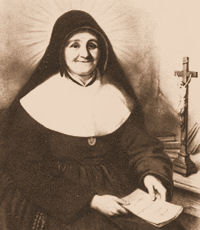Easter: April 8th
Friday of the Second Week of Easter
Other Commemorations: St. Julie Billiart, Virgin (RM)
» Enjoy our Liturgical Seasons series of e-books!
Grant him, O Lord, eternal rest, and may perpetual light shine upon him.
It is right, O God, to sing to thee a hymn in Zion, and in Jerusalem render thee a vow: Grant him, O Lord, eternal rest, and may perpetual light shine upon him.
Thou hearest our prayers, to thee all flesh must come. Grant him, O Lord, eternal rest, and may perpetual light shine upon him.
Between the fourth and sixth day after death (that is, on the 5th, 6th or 7th day of the mourning period) a Solemn Funeral Mass is celebrated in St. Peter’s Basilica for a deceased Pope. In John Paul II's case the funeral and burial is today, Friday 8 April 2005. The principal celebrant is always the Dean of the College of Cardinals, who at the time of Pope John Paul II's death is Joseph Cardinal Ratzinger, Prefect of the Congregation for the Doctrine of the Faith during John Paul's Pontificate.
 The Solemn Funeral Mass is concelebrated by the other Cardinals, the Patriarchs, Archbishops and Bishops, Prelates of the Papal Household, Abbots, religious and Roman clergy. Noteworthy in the Funeral Mass are the singing of the Gregorian Introit (entrance chant) "Requiem aeternam dona eis domine" (Eternal rest grant unto him, O Lord), the rite of Commendation (with the blessing and incensing of the body), and the Farewell at the end of Mass with its hymn "In Paradisum deducant te angeli" (May the angels lead you into paradise).
The Solemn Funeral Mass is concelebrated by the other Cardinals, the Patriarchs, Archbishops and Bishops, Prelates of the Papal Household, Abbots, religious and Roman clergy. Noteworthy in the Funeral Mass are the singing of the Gregorian Introit (entrance chant) "Requiem aeternam dona eis domine" (Eternal rest grant unto him, O Lord), the rite of Commendation (with the blessing and incensing of the body), and the Farewell at the end of Mass with its hymn "In Paradisum deducant te angeli" (May the angels lead you into paradise).
The deceased Pope is then buried. These ceremonies include covering the face with a veil of white silk, placing at the feet of the deceased pope a red silk bag containing bronze and silver medals from each year of his pontificate, the reading and signing of the official notification of burial, which is then inserted into a lead tube, sealed, and placed in the coffin. After the coffin is closed, it is sealed and placed in a lead coffin, which itself is sitting in an outer coffin of oak. Finally, the coffins are hermetically sealed and placed in the “ground” (that is, below the floor level of the crypt), over which is placed a marble slab bearing the the Pope’s name. Pope John Paul II will be buried in the crypt of St. Peter’s Basilica.
May the Angels conduct you to Paradise: And at your coming may the Martyrs receive you. May they lead you to the holy City of Jerusalem.
And may you, with Larzarus – once a poor man – Possess eternal peace. — EWTN
St. Julie Billiart
 Saint Julie was a woman completely immersed in God’s love and goodness, even in the midst of great suffering. She was a woman of vision who responded to the needs of the suffering world around her.
Saint Julie was a woman completely immersed in God’s love and goodness, even in the midst of great suffering. She was a woman of vision who responded to the needs of the suffering world around her.
Born in Cuvilly, France, on July 12, 1751, Julie lived a humble life in a loving family. She was a woman of serenity, despite the great personal suffering she endured. The Billiart family survived many hardships, including the deaths of several children. When Julie was 16, she went to work to help support her family. At the age of 23 she became paralyzed by the trauma of a shooting that was aimed at her father. She spent more than 20 years confined to her bed, unable to care for even her most basic needs.
Besides her physical pain, Julie suffered religious persecution, lived in hiding as a refugee. Throughout her suffering, she steadfastly trusted in God’s goodness. At the age of 53, Julie and her very good friend, Françoise Blin de Bourdon, along with two other women, made their vows as Sisters of Notre Dame in Amiens, France. A variety of difficult circumstances caused her to move her congregation to Namur, Belgium, several years later. Today these sisters are known as the Sisters of Notre Dame de Namur. Julie’s spirit and charism also influenced the Sisters of Notre Dame of Amersfoort, The Netherlands, as well as our own congregation of the Sisters of Notre Dame, which began in Coesfeld, Germany.
Julie reached out to the poor and forgotten, she brought comfort and hope to those around her, she encouraged faith in the seeking and the lost. More than anything else, she was a witness to the deep, loving goodness of God. Her motto and mantra was: “Oh, how good God is!” In 1969 Julie was named a saint by the Catholic Church. The impact that Saint Julie had on the world continues through the life and ministry of the sisters who share in her heritage.
—Excerpted from The Sisters of Notre Dame
Patronage: against poverty; bodily ills; impoverishment; poverty; sick people; sickness
Highlights and Things to Do:
- Read more about St. Julie:
- The Sisters of Notre Dame de Namur are still active.






